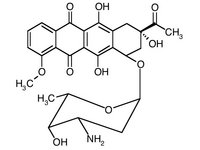INTRODUCTION: Voriconazole and caspofungin are two novel antifungal agents recently approved by the Food and Drug Administration for the treatment of disseminated fungal infections. Voriconazole may cause visual and gastrointestinal disturbances but cardiac events are rare and complete heart block (CHB) is exceptional. Caspofungin may cause phlebitis and liver abnormalities but has not been known to cause any cardiac side-effects. We present a case of CHB in a 44-year-old man with acute myeloid leukemia (AML) and no history of cardiac disease who received caspofungin and voriconazole as treatment for disseminated fungal infection. To our knowledge, this is the first case of CHB associated with the combination of these two agents.
CASE PRESENTATION: A 44-year-old man with a 10-year history of Crohn's disease was diagnosed with AML. He received induction therapy with idarubicin and cytarabine followed by consolidation with cytarabine. He was treated with empiric antibiotics for neutropenic fever. Computed tomography (CT) revealed microabscesses of the lungs, liver, spleen and kidneys suggestive of disseminated fungal infection. He was treated with voriconazole for one month without any side-effects. A follow-up chest CT showed enlarging microabscesses of the liver and spleen. Therefore, he was hospitalized for modified antifungal treatment using a combination of intravenous (W) voriconazole and caspofungin. The admission electrocardiogram (ECG) revealed normal sinus rhythm (NSR) [Figure 1A]. A week after hospital admission, he began complaining of chest discomfort. ECG revealed CHB (Figure 1B). Cardiac enzymes, serum electrolytes and renal and hepatic function were normal. Because of the CHB, he was transferred to the intensive care unit (ICU) for cardiac monitoring. In the ICU, the voriconazole was substituted for IV liposomal amphotericin and the caspofungin was continued. Transthoracic echocardiogram was normal. Serum titers of antibodies against Borrelia burgdorferi, Coxsackie B virus, Echovirus, and of anti-nuclear antibodies were negative. Bacterial and fungal cultures of blood, urine, and sputum were non-contributory. Over the next several days, the ECG evolved from intermittent CHB to type I second-degree atrioventricular block, and finally to NSR (Figures 2A-B). The chest discomfort resolved. The microabscesses disappeared on caspofungin and liposomal amphotericin. He was not re-challenged with voriconazole. He remained in NSR several months later.
[FIGURES 1-2 OMITTED]
DISCUSSIONS: Cardiac side effects have been reported with voriconazole in < 2.5% of patients in preclinical trials. These cardiac side effects have ranged from prolonged QT interval, bradycardia and bundle branch block to supraventricular and ventricular dysrhythmias, and even cardiac arrest; CHB was exceptionally rare. The mechanisms of these dysrhythmias are unclear since these cardiac events were demonstrated in severely ill patients with multiple medical problems and also receiving several other medications. Thus, a direct relationship between the arrhythmias and voriconazole could not be firmly established. There have been no reported cardiac side effects with the use of caspofungin. While there has been no documented adverse cardiac interaction of voriconazole and caspofungin, we hypothesize that the combination of voriconazole and caspofungin was responsible for the occurrence of CHB in our patient. He developed the CHB only after he was started on combination therapy with voriconazole and caspofungin despite having received voriconazole for one month without side effects. He was not on any other medications and the workup was negative for secondary causes of heart block. Additionally, once voriconazole was stopped, the CHB subsequently resolved over the course of two weeks despite ongoing treatment with caspofungin.
CONCLUSION: Combination antifungal therapies for disseminated fungal infections are being increasingly used, although the safety of these regimens has never been established. Clinicians should be cognizant that CHB is a potential and reversible side effect of voriconazole when combined with caspofungin for the treatment of disseminated fungal infections.
REFERENCE:
(1) Vfend (voriconazole) [package insert]. Pfizer Pharmaceuticals, 2002
DISCLOSURE: Svetolik Djurkovic, None.
Svetolik Djurkovic MD * Louis Voigt MD Eileen McAleer MD Brandi Ross-Douglas MD Stephen M. Pastores MD Neil A. Halpern MD Memorial Sloan-Kettering Cancer Center, New York, NY
COPYRIGHT 2005 American College of Chest Physicians
COPYRIGHT 2005 Gale Group



